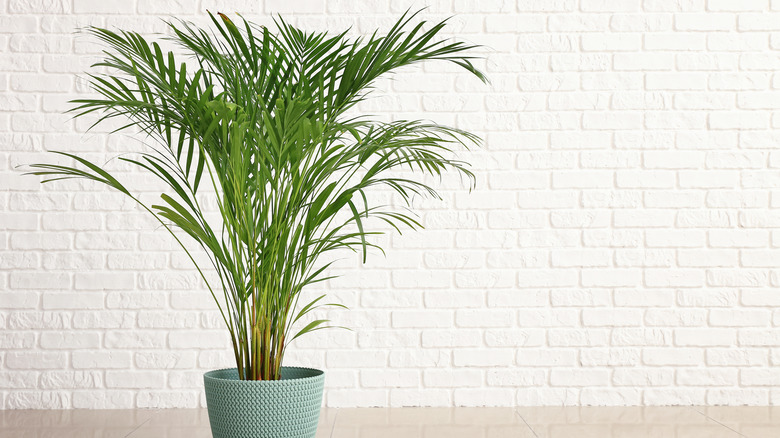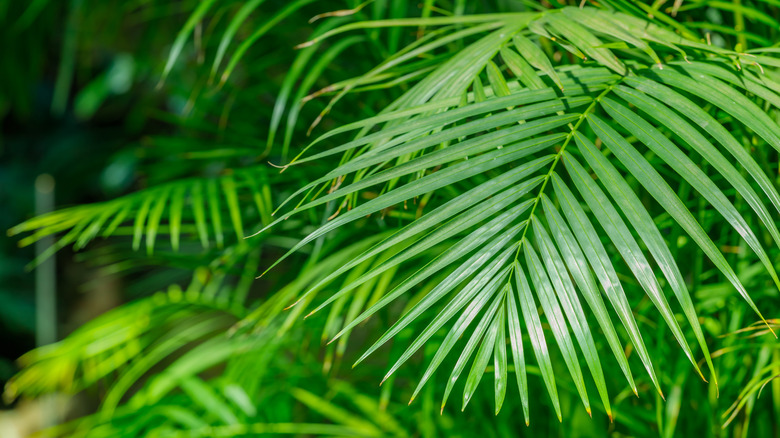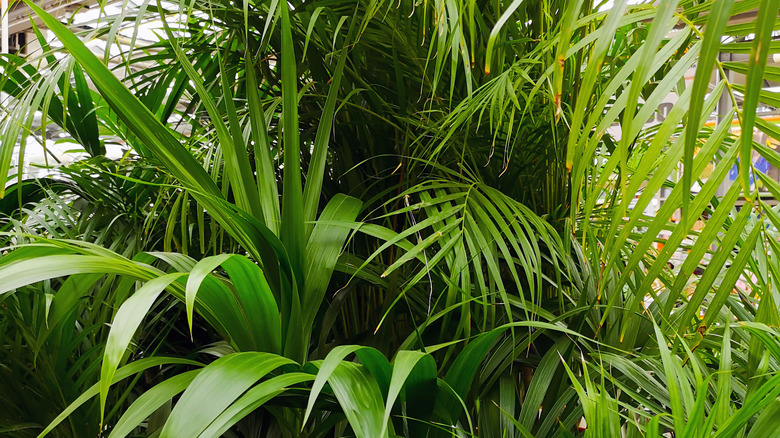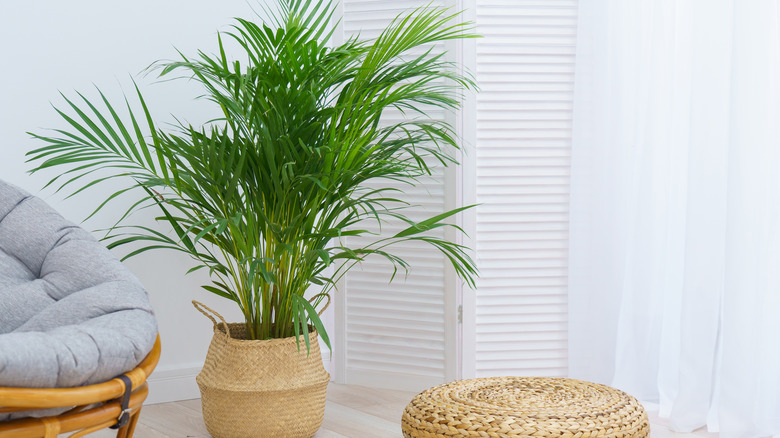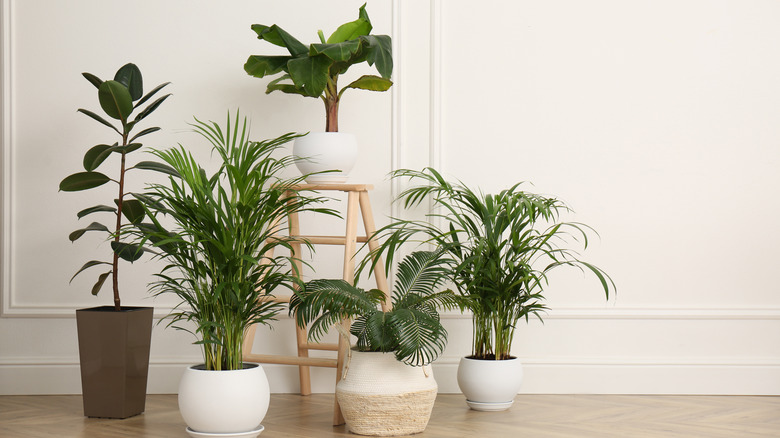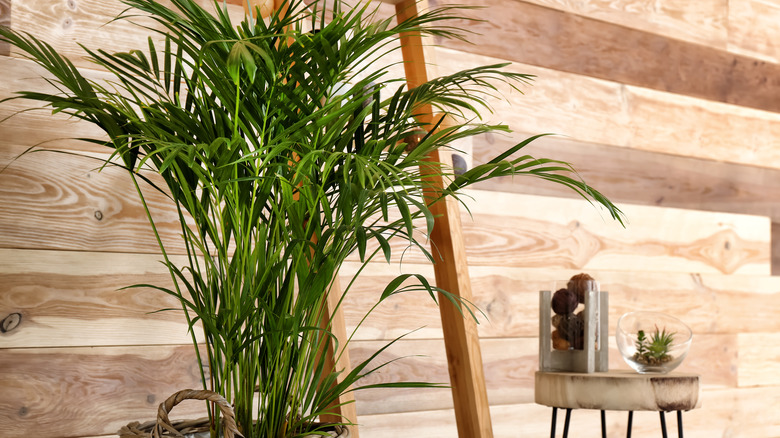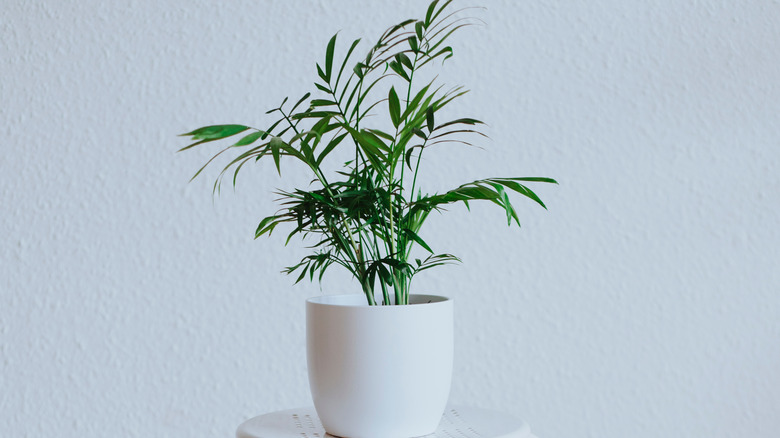How To Successfully Grow An Areca Palm
The areca palm is one of the most popular palm plants, sporting large, arching fronds, and is commonly found outdoors in warmer climates. Native to Madagascar, the areca palm, also known as dypsis lutescens, bamboo palm, golden cane palm, yellow palm, and butterfly palm, is a gorgeous addition to both indoor and outdoor spaces (via The Spruce). NASA charted it as one of the best plants for air purity, per SFGate.
The areca palm, once endangered, is now one of the most commonly identifiable palm trees — so much so that it's considered an invasive species in parts of Florida, according to SFGate! As an indoor plant, the areca palm is relatively easy to care for, but is not as tolerant to neglect as many popular, low-maintenance houseplants.
The areca palm can grow quite tall both indoors and outdoors. With its expansive green leaves, golden, bamboo-like trunks, and stunning presence when fully grown, the areca palm is an excellent option for your home, office, and even your backyard.
How to use areca palm in garden
Areca palms are a very popular outdoor plant, growable in warmer climates. According to The Spruce, areca palms are commonly used to increase privacy. South Florida Plant Guide says these palms grow in clusters, making them an effective privacy hedge, growing up to 20 feet tall and 10 feet w++ide. They recommend planting each tree 3 to 6 feet apart. Its height and density can also aid in providing shade, which is particularly helpful in the warm climates it grows in. If you're looking to add areca palm to your garden, make sure you are located within USDA growing zones 9 through 11, such as Hawaii, Southern California, Southern Florida, etc.
The best outdoor light conditions for the areca palm will provide it with bright, filtered light. They can tolerate full light, but should avoid being put in the path of the afternoon sun's direct rays to avoid scorching. They do best in more acidic soil, ideally around 6.1 to 6.5 pH (via SFGate). Water when the soil begins to dry out. Areca palms cannot be left to dry out, and they cannot tolerate being overwatered. Since the areca palm is only conducive to warmer environments when grown outdoors, they will need frequent monitoring to ensure they are being given proper watering conditions. Fertilize in the spring, preferably with a slow-release palm fertilizer.
How to grow areca palm
Areca palms can be grown from seed or by planting a previously grown plant purchased from a garden center. According to Hunker, the first step is to clean the seed's fleshy outside by running them under water while rubbing them against a mesh screen. Next, they say to soak the seed in white vinegar.
Next, fill a small germination pot with a palm potting mix, add one seed to the pot, and spray it with water from a spray bottle. Keep the germination out of direct sun and at around 80 degrees, and look for sprouts in a few weeks! Once the areca palm grows a few leaves, its time to replant it.
If you would like to replant the areca palm in a pot to keep indoors, repot the baby plant into a pot of your choosing, and care for it as you would a full grown indoor areca palm. If you would like to replant it outdoors, make sure you do so before it becomes root bound. Dig a hole where you would like to plant it, mix in topsoil and peat moss, and plant your areca palm. Care for it as you would any outdoor areca palm.
How to care for areca palm
The areca palm is a great addition to your indoor space, and a very popular choice amongst houseplants. The areca palm has relatively easy care needs, but as stated earlier, will not tolerate neglect. While the following care steps are easy, they are strict, and should be followed regimentally.
The areca palm will do best in bright, indirect light. Direct sunlight will scorch the leaves. It is recommended to keep this plant by a south or west facing window, but again, avoiding direct sun (via Guide To Houseplants). Additionally, the areca palm is a little particular when it comes to watering. Apartment Therapy says the quickest way to kill areca palm is by overwatering and not allowing enough drainage, so make sure you are not drowning your palm or potting it in a poorly drained pot. The soil should be allowed to slightly dry out between watering, but not completely, and allowed to drain completely when watered. Water less in the winter. The areca palm also prefers distilled or filtered water for watering.
This plant requires fertilization from spring to early fall, preferably a liquid palm fertilizer. Avoid fertilizing during its dormant months from late fall to winter.
Varieties of areca palm
The areca palm is not the only kind of palm that can liven up your space. In fact, there are over 2,600 species of palm trees, some of them up to possibly 56 million years old, per Home Stratosphere. While the areca palm is a great option for your home, here is a list of a few more popular options from The Spruce:
-
Chinese Fan Palm: This slow-growing palm is easy to care for and can grow up to 15 feet tall.
-
Parlor Palm: Visually very close to the areca palm, the parlor palm is suited best for indoors and is also quite easy to maintain.
-
Yucca aloifolia: This palm is commonly known as the Spanish bayonet due to its razor sharp leaves, and is best suited for the outdoors.
-
Yucca elephantipes: This is the spineless variety of the aloifolia, and is an excellent and safe addition to an indoor space.
-
Majestic Palm: If you want a palm in a low light room, the majestic palm is perfect for you, so long as you are able to provide it the correct moisture and humidity levels.
Is areca palm toxic?
Not only is the areca palm beautiful, relatively easy to care for, and a good air purifier, but it is also non-toxic! The ASPCA says the areca palm is non-toxic to dogs, cats, and horses. Of course, this doesn't mean you should be eating or encouraging your animals to eat the plant, but a trip to the vet won't be necessary if your furry friends get into your palm. That being said, do keep an eye on your pets getting into the plant. Preventive Vet warns that cats have a tendency to become curious over the plant's fronds, and consuming a whole frond can lead to a gastrointestinal obstruction.
As a bonus, the areca palm is one of very few non-toxic indoor palm plants. SFGate states one of the other very popular indoor palm plants, the sago or cardboard palm, is very toxic to pets. The areca palm is a great option for people wanting the elegant look of a palm in their home that won't turn into a vet bill.
How to repot areca palm
Areca palms like being root bound, so repotting is not a regular necessity. According to Gardening Know How, the main reason to repot your areca palm is to get rid of the old soil and remove salt and fertilizer build up. You only need to repot this plant every two to three years. You can even keep it in the same pot if the root ball still fits relatively well. If you do need to get a different pot, only go a size up, and make sure the pot is the same depth as the palm is currently in. Make sure your pot, old or new, has plenty of drainage holes.
Make sure you water your plant the day before. If your plant is in a plastic nursery pot, gently squeeze the sides and remove to plant. The roots are brittle, so don't break them up as much as you usually would. Just remove as much of the old soil as you can. When transferring your plant into its new pot, be very careful to ensure it's sitting at the same depth level as it was before. Add soil around the roots and pack down tightly with your hands. Flood the plant with water and let drain to get rid of any air pockets, adding more soil if necessary.
